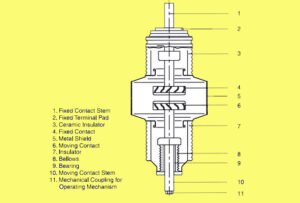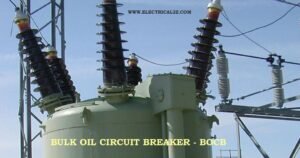Table of Contents
What is Minimum Oil Circuit Breakers?
These minimum oil circuit breakers utilize oil as the interrupting media. However, unlike bulk oil circuit breakers, these designs place the interrupting units in insulating chambers at live potential. This feature of the design of MOCBs reduces the requirement of oil, and these breakers are therefore known as MOCBs.
MOCBs Voltage Range
These designs are available in voltages ranging from 1000 V to 765 kV using the multi-break technique. A typical view of 36 kV MOCB indicating main parts is shown in the image.
MOCBs Applications
This type of breaker is widely used in transmission and distribution network. A modern innovation in this field is the achievement of current interrupting capacity up to 50 kA with the interrupter heads hermetically sealed and lightly pressurized with dry nitrogen. In this type of construction, moisture, which has the most detrimental effect on oil, is kept out which facilitates long service life. Unit ratings up to 145 kV with single interrupter and 245 kV with two interrupters per pole have been developed for transmission application.
 |
| 36 kV – MOCB |
In an oil circuit breaker, the arc drawn across the contacts is contained inside the interrupting pot and thus the hydrogen bubble, formed by the vaporized oil (gas) is also contained inside the chamber. As the contacts continue to move and when the moving contact rod separates itself from the orifice at the bottom of the chamber, an exit similar to a nozzle becomes available for exhausting the hydrogen that is trapped inside the interrupting chamber.
 |
| Cross-section of interrupting chamber |
It is well-known that minimum oil circuit breakers are sensitive to high TRV peak and prone to restrikes during switching capacitor banks. However, this problem has been effectively countered by pressurizing the interrupter heads with dry nitrogen.
These types of breakers were found to be more suitable for applications in countries with very low ambient temperatures like Canada, Russia and Finland, where the gas blast circuit breakers become more sensitive to icing and liquefaction problems.
Due to their cross blast designs, minimum oil HV circuit breakers suffer from few major inherent problems such as sensitivity to high peak voltage and the effects of pre-arcing. Usually the out-of-phase switching test is the most difficult, test on MOCBs, which generally dictates the number of interrupters to be used in series for a particular voltage class.
The energy released due to pre-arcing is very high and high strength insulating materials are required to enable cross jet pots and jet plates to withstand high-pressure surges. The number of breaks per pole also depends upon the ability of the arc interrupting chamber to withstand the energy released due to pre-arcing, which is a function of current in the arc and voltage per break.
Presently this technology is considered outdated due to the advent of VCB technology in medium voltage and SF6 technology in the high voltage range.
Final Word
Hope you understand this article about MOCBs. Incase of any doubt please comment below. Subscribe our website to get every new post update to your email. Please follow our website – ElectricianWorld.net for future updates. Thank you for visiting our website.



